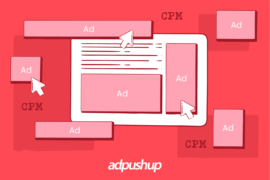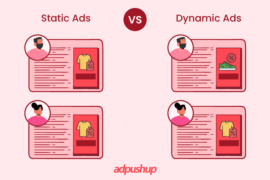In the digital advertising world, RPM and CPM are two metrics to monitor ad revenue. Let’s understand the difference between RPM and CPM.
Let me guess, you were looking through your AdSense account, checking your earnings and noticed a difference in your RPM and CPM rates. The numbers didn’t match. And now you are confused about which one to go after to understand your earnings.
Well, you are not alone. RPM and CPM are two metrics that often confuse publishers.
So, let’s start with the basics and then understand the difference between them.
What is CPM?
CPM stands for Cost Per Mille or Cost Per Thousand Impressions. It’s a popular term used by digital advertisers and marketers. It’s an advertiser-side metric used to track the campaign expense. Every time a CPM model-based ad serves an impression on a publisher’s web page, the publisher earns from it. This model is different from CPC (cost-per-click) ads, where users need to click on an ad for a publisher to make money.
The formula to calculate CPM:
CPM = (Cost of the campaign / Number of impressions) * 1000
Here is an example to simplify it:
Suppose an advertiser sets a budget of $4000 for a CPM-based campaign. He invests in an inventory with a total of 4,000,000 (4 million) impressions. What will be the advertiser’s CPM?
(4000 / 4,000,000) * 1000 = $1 CPM. This is the amount the advertiser will pay you (the publisher) for each impression.
What is RPM?
Revenue per Mille or Revenue per Thousand Pageviews is the estimated earning of publishers based on the number of page views received. Here, RPM is the publisher-side metric that gives them a general idea about their earnings. However, the actual earnings after the ad are served can be more or less than the estimated RPM.
The formula to calculate RPM:
RPM = (Estimated earning / Number of pageviews) * 1000
Here’s another example to simplify it:
Suppose a publisher estimates his revenue, based on past records, to be around $600 for 600,000 pageviews. In that case, the RPM would be:
(600 / 600,000) * 1000 = $1 RPM. This is the estimated amount the publisher should expect to get.
What is the Confusion About RPM vs CPM?
CPM is an advertiser metric, while RPM is a publisher metric. Though Google AdSense uses RPM to tell publishers about their earnings shows CPM-based ads; this is the source of confusion.
Also, RPM is usually higher than CPM. This is because RPM measures the cost based on pageviews and the number of ad units on a web page. Whereas CPM retrieves the cost based on the number of impressions per ad unit.
For instance, a user visits a webpage with four ad units. Out of the four, one ad unit is placed below the content. Now, a user scrolls through the webpage to a point where only three ad units can serve impressions. In such a case, the CPM will be based on the number of ad units which received the impressions (which is three), whereas the RPM would be estimated by counting all four ad units. Similarly, if a publisher deals in 100,000 or more impressions a month, this difference increases.
This is the reason publishers often see a huge gap between CPM and RPM, pushing them to think something is wrong with their business practices. But at the same time, if you’re implementing the right practices to increase RPM, there is nothing for you to worry about.
Read More: Page RPM AdSense: Definition, Calculator, and Tips to Increase It
RPM vs CPM: Which Should You Use to Analyse Earnings?
It’s up to you. Google AdSense shows publishers’ earnings via RPM. However, most ad networks consider CPM to show the publishers their earnings. But to note, none of these metrics, viz. CPM or RPM is accurate. These numbers are based on estimates, and hence the actual earnings can be different.
Now, RPM is great for keeping track of your earnings. It provides you with a goal that you can achieve. But, publishers shouldn’t focus on only RPM. Working only on RPM can backfire一you add more number of ad units per page to increase the RPM. But this might disrupt the user experience and increase your bounce rate. Also, too many ads can damage your site’s viewability score. The next thing you will notice is a significant fall in your earnings.
Next, CPM. A good CPM correlates with good quality content and hence a good viewability score. Also, CPM depends on the advertiser’s budget and requirements. If a publisher’s inventory fits well as per the advertiser’s requirement, then the advertiser will likely spend more on such inventory. By working to increase the CPM, publishers will try to improve the earnings of each ad unit per page. This will encourage publishers to provide proper space for content and ads, finally serving the better-performing ads.
Conclusion
RPM is the metric for publishers to estimate their earnings. Whereas CPM tells about the amount, the advertiser is going to spend on the ad campaign. Also, publishers’ earnings are ever-fluctuating because it depends on multiple factors that make it difficult to measure accurately. The factors that the measurement is dependent on are:
- User behaviour is like whether the user is going to click an ad or not.
- How much time the user is going to spend on the web page?
- Whether or not the page is optimal to provide a good user experience and ad viewability.
Above all, irrespective of any metric used to calculate the ad revenue, RPM or CPM, the earnings will always be established by the number of impressions you get.
FAQ Related to RPM vs CPM
RPM measures the cost based on pageviews and the number of ad units. And CPM calculates the cost based on the number of impressions per ad unit. Both are important for ad publishers.
Suppose, for every 1000 page views, the 5 ad units will return a revenue of $8.75. Thus, CPM = (CTA/page views)* 1000 = ($0.05/40)*1000=$ 1.25.
For example, if there are 5 ad units on a page and $0.35 is the estimated earnings from 40 page views. So, the RPM will be 0.35/40*1000= $8.75.

Shubham is a digital marketer with rich experience working in the advertisement technology industry. He has vast experience in the programmatic industry, driving business strategy and scaling functions including but not limited to growth and marketing, Operations, process optimization, and Sales.







